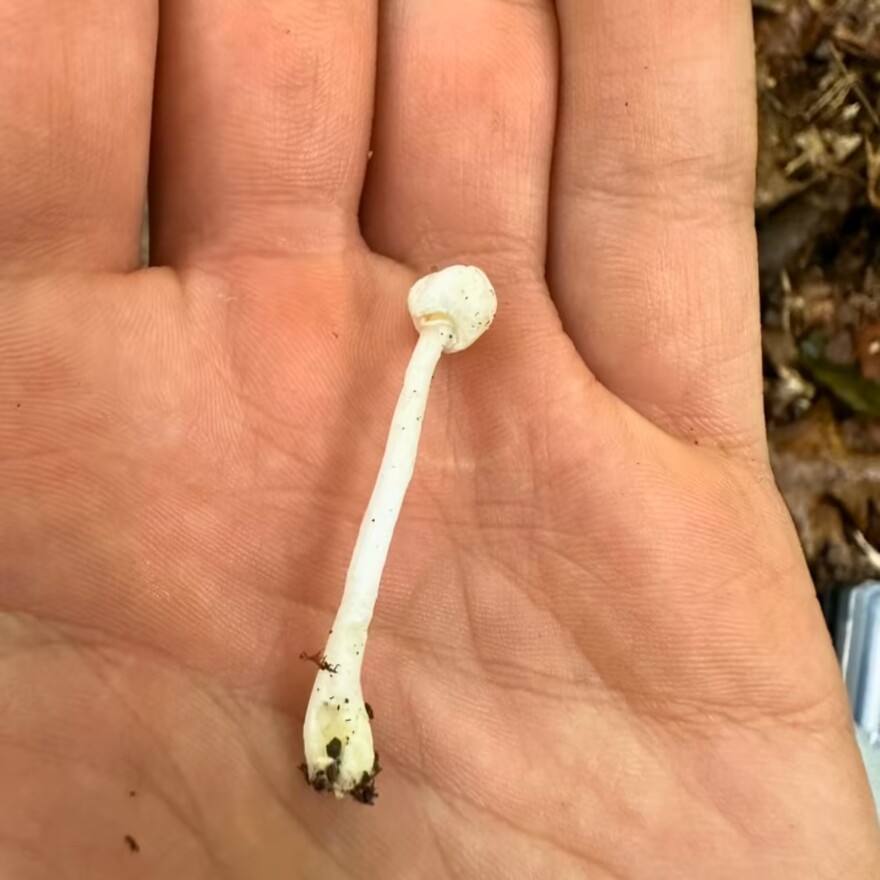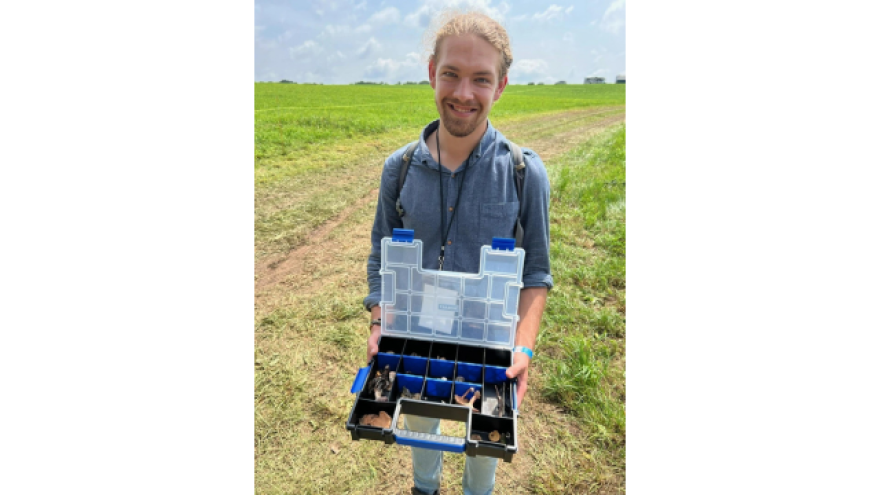EMMAUS, Pa. — Last summer — and for years prior — it was typical for Will Yaeger to spend his weekends walking the Lehigh Valley’s preserves and wooded areas, his tacklebox of supplies in hand, searching for mushrooms.
“Fungi, or mushroom-forming fungi, are often really ephemeral,” said Yaeger, a recent Lehigh University graduate who studied molecular biology and biocomputational engineering. “They send up a mushroom and it's there for two or three days, and then a heat wave comes or an animal comes or it just melts away, because some mushrooms just do that, and then it's gone.
“And so, it's important to be really regularly going out and documenting in order to catch all of that full diversity that you might otherwise miss.”
But, the last Saturday of August of 2023 was anything but typical. Yaeger made a discovery — a new species of mushroom growing in Wildlands Conservancy’s South Mountain Preserve. After collecting the small, white mushroom near the Alpine Street Trail, Yaeger sent the specimen for DNA testing. Researchers confirmed it was entirely new and didn't match anything previously recorded.
The mushroom now has a temporary name — Leucoagaricus sp-PA01, the code at the end denoting it’s the first time the new species has been recorded in the commonwealth.
“The fact that I was able to find something that's not been documented before, that's new to science, right here in the Lehigh Valley, in an area that's been fairly well studied, is pretty cool."Will Yaeger
“The fact that I was able to find something that's not been documented before, that's new to science, right here in the Lehigh Valley, in an area that's been fairly well studied, is pretty cool,” Yaeger said. “And, hopefully it gets people excited about studying fungi and contributing to our understanding of their diversity in the same way that I try to do when I go out and observe and collect.
“It's a relatively beginner-friendly sort of endeavor — anybody, including a college student who's going for a hike on the weekend, can do this. You don't have to be a Ph.D. mycologist or anything.”

‘Mushrooms are definitely having their moment’
A mushroom can be defined as the part of a fungal organism that produces spores, said Veronica Rosenberger, senior communications specialist with Wildlands Conservancy. For much of scientific history, they were lumped in with plants, and it was only several decades ago that fungi were given their own kingdom.
“Mushrooms and fungi were only known to be their own kingdom of life the same year as the moon landing. Up until 1969, you could open a book about plants and find mushrooms in it.”Veronica Rosenberger, senior communications specialist with Wildlands Conservancy
“Mushrooms and fungi were only known to be their own kingdom of life the same year as the moon landing,” said Rosenberger, a local fungi enthusiast who also leads fungi forays for the conservancy. “Up until 1969, you could open a book about plants and find mushrooms in it.”
In the years since, researchers have shown that fungi are actually more closely related to animals than plants — also revealing how much there is left to learn about them.
There are an estimated 2.5 million species of fungi in the world, according to the 2023 State of the World’s Plants and Fungi report – but only 155,000 have been named, meaning “more than 90% of fungal species remain unknown to science.”
“The race is now on to find, describe and name those species — which may contain valuable medicinal compounds or possess other useful properties — at a time when biodiversity loss is at crisis point,” according to the report.
Studies show that more microdiversity in a forest equates to more biodiversity, which bolsters growth, creates better air quality and increases water filtration.
“When you put fungi under conservation, it protects the entire ecosystem, and it protects us,” Rosenberger said. “From a conservation standpoint, they are definitely neglected, unfortunately, and have a lot of connection to the rest of the world – literally, through mycelium, but then also just through the health of the ecosystem.”
And, environmental advocates can’t conserve a fungi they don’t know about.
“There's definitely a lot of opportunity and a lot of knowledge gaps to fill, even within documentation,” Rosenberger said. “But then taking it one step further, under conservation … comparatively to plants, the amount of mushrooms red listed under the IUCN is a lot less, even though in pretty much any given ecosystem, mushrooms outnumber plants six to one.
“And no mushroom species are included in the Endangered Species Act — zero — even though we have millions of mushroom species worldwide.”
The International Union for Conservation of Nature’s Red List of Threatened Species, established in the mid-1960s, focuses mostly on mammals, amphibians, birds, reef building corals and conifers, but does list a handful of mushroom species at risk for extinction.
In recent years, there’s been a grassroots effort, with hobbyist or amateur mycologists spending their free time in the woods, just like Yaeger. And it’s paid off — since the beginning of 2020, more than 10,200 fungal species have been described as new to science.
“From a community standpoint, mushrooms are definitely having their moment right now,” Rosenberger said. “There's a lot of people going out and looking to see what they can identify, what they can forage and eat. From a conservation standpoint, we still have a long way to go.”
‘Oh, finally! Gotcha’
Yaeger started at Lehigh in 2020, when COVID-19 restrictions kept residents and students from mingling indoors. So, he turned his attention to the outdoors.
During the weekends, Yaeger took his tackle box and searched for mushrooms. He explored Lehigh’s more-than-2,000-acre campus before adventuring into nearby parks and preserves, including South Mountain.

“South Mountain Preserve was one of the places that I soon sort of identified as a really cool, interesting place to look for fungi,” he said. “A, because it's big, and B, because it's been stewarded really well by the Wildlands Conservancy.
“There's minimal presence of invasive species. There's been minimal development and disturbance, once you get into those sort of deep parts of it, and some diverse topography, so lots of cool opportunities to find diverse fungi.”
As he learned more about fungi, Yaeger realized how much he could contribute.
“I was reading a lot about them, and sort of quickly understood that this was an area where somebody like me who was passionate and willing to put in the time to learn and to document and collect could really make an impact,” he said. “That's really exciting, because a lot of the time, doing science can be hard for somebody without formal training.”
But, during his years at the university, he was able to get that training, as well as access to a lab to continue his studies.
Gregory Lang, an associate professor in the department of biological sciences at Lehigh, remembered the first time he heard from Yaeger. As a freshman, Yaeger reached out to Lang with some questions via email as he worked on a project growing oyster mushrooms.
“Will immediately struck me as someone who's really smart and motivated and curious — all these really great traits that are essential to be a good scientist, but really hard to teach.”Gregory Lang, associate professor in the department of biological sciences at Lehigh
“I'm accustomed to getting emails out of the blue about students that want to talk about genetic engineering or human disease or these kind of more hot topics that are more biomedically related,” Lang said. “This is kind of unusual to get an email about someone interested in some relatively understudied group of fungi, so I kind of jumped at it and said, 'I kind of want to meet this kid, because this seems interesting.’
“Will immediately struck me as someone who's really smart and motivated and curious — all these really great traits that are essential to be a good scientist, but really hard to teach.”
Yaeger carried those traits with him into South Mountain Preserve on the August day he made his discovery.
“I was collecting, and at one point, I came upon this area where there was kind of a little drainage ditch, or like a dry creek bed,” he recalled. “I was sort of looking in that area, because fungi like to often grow in damper, lower elevation areas where the water collects.
“I found a bunch of things there, but one of the things I remember finding was this species that we now know is a kind of Leucoagaricus. And I remember making a note on my phone when I found it that this was not one I had seen before, which was exciting. And so I collected it.”
After taking photos — his camera battery has died, so all he has are those on his iPhone — he took the specimen home to dehydrate and send it, along with others he found, for DNA testing.
Four months later, he got the news — Yaeger had found a new mushroom.
“I was excited, but not necessarily surprised,” Yaeger said when he got the results back. “It was actually more like, ‘Oh, finally! Gotcha.’”
Yaeger could go through a process to name the new species, but he would have to provide a sample to a herbarium or a museum.
“Unfortunately, I only found the one specimen, and I sent it off for DNA sequencing, which is sort of inherently a bit of a destructive process,” he said. “ … I don't have what they call the type specimen, or the holotype to submit. And so for that reason, right now, I can't name it.
“But if I find another one, or if somebody else finds another one, either in that same spot or in a different spot, and the DNA matches, then that could be submitted, and then the naming process could commence.”
Asked if he would name it after himself, Yaeger chuckled, adding “I don’t think so.”
During his time at Lehigh, Yaeger ended up working two and a half years in Lang’s lab, completing his senior thesis on complex genetic traits in hybrid yeast before graduating in the spring. Now, he’s in Peru, working and studying as a Fulbright scholar with plans to start next year in a doctorate program at the University of Chicago.
“I'm really interested in nature and understanding it,” he said. “I think that especially nowadays, with the kinds of technological capabilities that we've been developing over the past few decades, there's tremendous potential to better understand the organisms and ecosystems around us using these kinds of molecular biology and computational tools.
“ …My goal is really to sort of work at the intersection of the sort of more field-based ecology and natural history disciplines with molecular biology and genomics.”


